![]() 1st Battalion 22nd Infantry
1st Battalion 22nd Infantry ![]()
MEDAL OF HONOR
Macario Garcia
Company B 1st Battalion 22nd Infantry
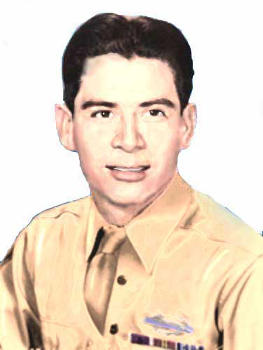
A colorized photo of Macario Garcia taken without his Medal of Honor
Note: The information presented
here for Macario Garcia's military service is from the best
available research as of June 2017.
The 1st Battalion website does not have access to Garcia's
personal records or to a certified copy of his service details.
A request has been sent to the National Personnel Records Center
asking for copies of Garcia's service files in an attempt
to document his service accurately and completely. Should the
NPRC furnish additional details or correct details presented here
such information will be added to this presentation.
The enlistment record for
Macario Garcia indicates that he was drafted into the Army on
November 11, 1942
at Houston, Texas. His home of residence was listed as Fort Bend,
Texas. His year of birth was listed as 1920
and place of birth as Mexico. He tood five feet five inches tall
and weighed 123 pounds. His education level
was listed as Grammar School and his civilian occupation was
listed as Farm hands, general farms. At the time
of his induction he was single with no dependents and was not a
US citizen.
He received a week of
indoctrination at Fort Sam Houston, San Antonio, Texas. On
November 21, 1942 he was
assigned to Company B 51st Training Battalion at Camp Robinson,
Arkansas for Basic Training. 1
After his initial training he
spent most of 1943 at Fort Benning, Georgia, as part of a
demonstration team at
Officers Candidate School, conducting live-fire demonstrations of
Infantry weapons to the candidates. 2
In April 1944 Garcia was shipped
to England and was assigned to the 4th Infantry Division's
Replacement pool.
As the 22nd Infantry Regiment sustained heavy casualties in the
days following the D-Day landing, replacements
were needed by the Regiment and sent to the 22nd Infantry in
batches from England. Garcia was sent in one of
those batches to Company B 22nd Infantry on June 17, 1944. He was
assigned to 2nd Platoon.
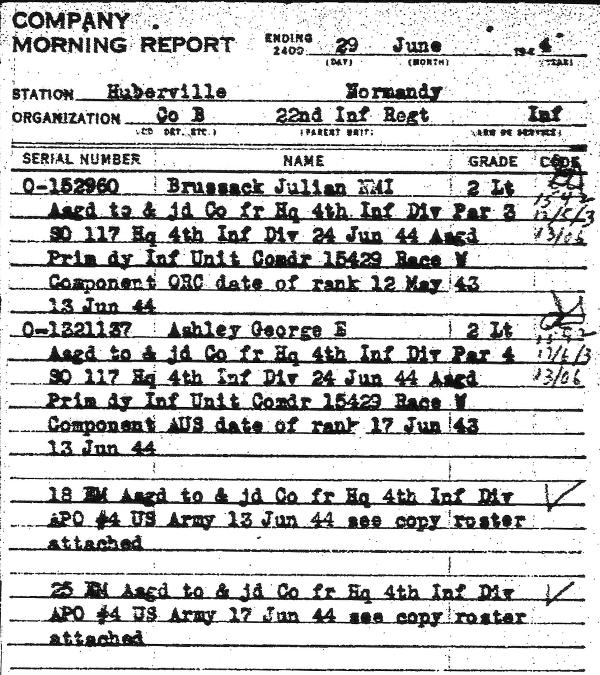
Above: A page from the
Morning Report for Company B 22nd Infantry of June 29, 1944.
The bottom entry shows that "25 Enlisted Men were assigned
to and joined the Company
from Headquarters 4th Infantry Division Army Postal Office #4 US
Army on June 17, 1944
see copy roster attached."
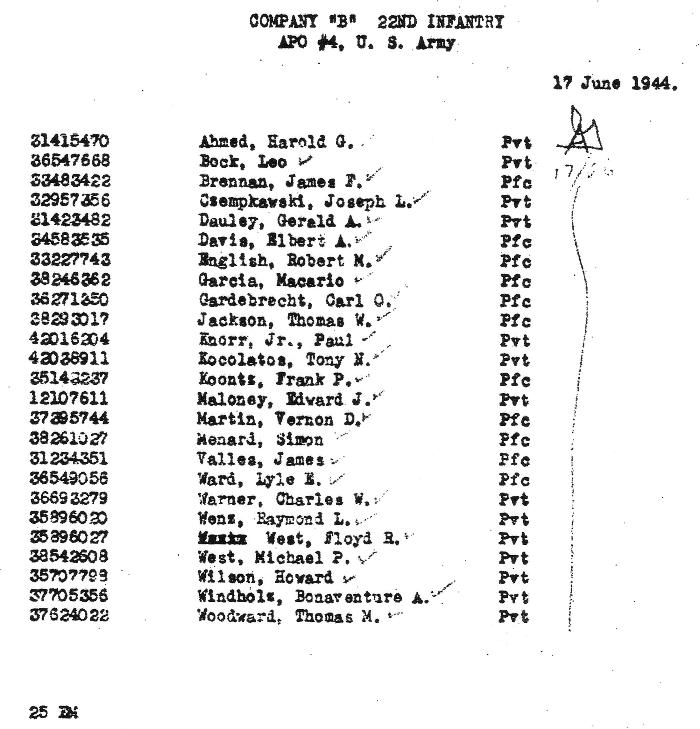
Above: The attached
roster to the Morning Report posted above which lists the
25 Enlisted Men assigned to Company B 22nd Infantry on June 17,
1944.
Macario Garcia's name is eighth from the top.
Garcia was wounded in Normandy
on June 19. 3 One report states
he refused evacuation and
returned to his unit the next day. Another report indicates he
returned to his Company on July 12.
A third report states his recovery took four months and he did
not rejoin his Company until a month
before his Medal of Honor action. 4
At some time Garcia became a
scout employed by Company B. A scout ranged ahead of the Company
sometimes alone but usually in concert with one or more other
scouts.
The best description of Garcia's
actions in combat are from his official biographers Robert and
Katherine Bailey.
In the passages below the authors relate episodes to illustrate
the kind of soldier Garcia was. The Lieutenant Tony Bizarro
mentioned in the passages was Garcia's Platoon Leader in 2nd
Platoon of Company B. Bizarro was highly decorated
and retired as a Major. Parts of Bizarro's phone conversations
with author Robert Bailey are in the following passages.
(September 16, 1944)
Along GERMANY'S
SIEGFRIED LINE, Macario Garcia, Private First Class, aka 'acting
Sergeant', Company B,
1st Battalion, 22nd Infantry Regiment, 4th Infantry Division, as
1st Scout was given the mission of obtaining information
concerning German troops opposing his company. He moved forward
into enemy territory and for a period of three hours
made observations of German activity. Although he was in danger
of discovery at any time by enemy patrols or outpost troops,
he escaped detection and returned to his company with vital
information concerning the location and disposition of
German troops. The results of his reconnaissance contributed
materially to the subsequent successful operations of
his company. He was awarded the Bronze Star for this brave action
and was cited for an outstanding accomplishment
that reflects credit upon himself and the military service.
This was not a
one time event for RFC Macario Garcia. "He was always well
forward." A few days after this Bronze Star
action, 1st Scout, PFC Macario Garcia was about five hundred
yards forward when an American tank, not believing a friendly
could be that far forward, fired into Macario's position and
wounded him. He did not receive a Purple Heart; it was
a friendly fire incident. 5
(September 30, 1944)
Garcia's
commanding officer told him to get up there about 500 yards.
Macario and his buddy, Jefferies, moved away
from the company and stretched out on the ground. Macario saw a
camouflaged machine gun nest and told Jeffries to stay put.
Macario crawled around and out flanked the German position, cut
the phone line and then slipped up behind the German and
took him prisoner. For this, PFC Macario Garcia, 1st Scout,
Company B, 1st Battalion, 22nd Infantry Regiment, 4th Infantry
Division was awarded a second Bronze Star (Oak Leaf Cluster).
During this couple of hours of scouting he was almost wounded
again when the Germans opened fire, and a bullet went through his
boot just missing his big toe.
Lt. Tony Bizzaro
said, "Garcia and Jeffries [Jeffrey] were two of the best
scouts I have ever seen. They had just plain guts,"
and they were always well forward.
Major Bizzaro
often choked up when he talked about Macario, and told Robert,
"There was nothing Macario would not do
for his buddies." He told Robert that Macario Garcia was the
best soldier in the U. S. Army. When Robert asked him how he
could say that, Major Bizzaro replied, "It was nothing you
could explain; there was just something about the way Macario
moved
and went into attack." 6
In another
scouting incident, PFC Macario Garcia and PFC Charles Jeffries
went forward with their B-A-R's thirty yards
in advance of their platoon and about the same distance from each
other. Three machine gun positions were reduced by
one of these scouts opening fire to draw fire, while the second
was working around to the flank of the gun, firing, and then
an assault squad of about fifteen men attacked the gun with a
steady rush of fire superiority. During these skirmishes
all Germans manning the machine gun nests were killed. This team
was a force to be reckoned with. 7
(November 27, 1944)
Col. Lanham
again ordered the gap between the 2nd and 3rd Battalions to be
closed. "This time Lieutenant Dickenson's
Baker Company received the assignment. Baker Company's attack
never really got started. German machine-gun crossfire
and artillery stopped the Company cold on the open ground that
Charlie Company had easily crossed the day before.
This day the open field turned into a meat grinder. Lieutenant
Dickenson and two other officers were wounded leading the attack,
and Lieutenant Tony Bizzaro, one of the two remaining officers,
assumed command. Seventeen of the eighteen men in the
1st Platoon were killed or wounded when caught in the killing
ground of an open area. When 3rd Platoon tried to cross the same
field,
it suffered almost the same treatment, with only twelve coming
back."
(Website Ed.: Casualty lists for
November 27, 1944 indicate that Garcia's Company suffered a total
of six killed
and twenty-nine wounded on that day.)
The bloodletting
stopped only when the Germans sent Charlie Company's wounded from
the previous day's fighting back
to the American lines. "Assisting the German medic
responsible for taking the wounded back was Tech 5 Bishop, who
had
awakened in the morning to find Germans all around him. He was
put to work caring for American wounded, and when
the Baker Company attacked stalled, both sides held their fire
while the two medics carried five wounded soldiers into
the American lines. Then the attack resumed."
Now Baker
Company was only about thirty strong. Second Platoon
"attempted to slip a squad at a time across the field.
Ten men [including Private First Class Macario Garcia and Charles
Edwards] got within twenty yards of the woods
before a machine gun pinned them down."
Macario Garcia
watched his buddy, Charles Edwards, stagger backwards with a
"round, white hole in his forehead,"
and saw that tragic look on his face when a man realizes in that
brief instance between life and death that he has been had.
Macario's memory was etched with the sight of Edwards' "life
blood spurting out in rhythmic, ebbing flow."
(A newspaper article from July 11, 1950, by Louis Blackburn)
Macario's luck
ran out when he was spun around, knocked to the ground and felt
the flash of pain in his right shoulder
like the prick of sharp knives and felt his blood bathe the right
side of his body. Even so, he calculated the cost in blood and
human life that had been poured out over the past sixteen days
for this few square miles. This was the day the fate of his
brothers fell on his shoulders. He summoned all his resolve and
strength and managed to crawl into the underbrush,
while the German machine gunner and riflemen tried to finish him
off. He sortied up the hill and through the woods,
captured two Germans and took them down the hill. He then went
back up after the machine gun. As he proceeded,
he faced off with a German rifleman. Although hit in the arm
during the exchange, Macario delivered the lethal shot.
He then killed
the two Germans manning the machine gun in the fortified bunker
with two shots of his M-1 and killed
three more trying to escape. He tossed in a grenade to be certain
the gunners were dead. Inside the bunker he opened their
blue tunics and saw their shrapnel riddled bodies; his nostrils
filled with acrid burnt gun powder, and he became nauseated; yet,
he felt elated about completing the mission. He broke the machine
gun, striking it against a tree.
Macario went
back down the hill to call his company up when another machine
gun opened fire, killing and wounding more
of his squad. Macario disappeared into the woods, maneuvering to
find the gun and got the jump on another German rifleman,
who "threw up his hands" and "babbled a pleading
torrent of German, fear welling in his throat." Not a wanton
killer, Macario
did not squeeze the trigger. He took the prisoner toward the
company, and turned back up the hill toward the machine gun.
Suddenly, a sniper fired three shots that pinged head high into
an oak tree. Macario fell on his face and rolled behind the
trunk.
He crouched there like a hunted animal. trying to figure out what
to do next. His "plight was reduced to basic mathematics -
it was me or the machine gunner! And the odds were all in his
favor." While contemplating, German artillery whistled
overhead seeking to decimate his buddies (Kill 'Em Like Rabbits,
as told to Zarko Franks)
Macario now
noticed the blood in his boots, the pain in his shoulder and the
weakness crawling over his body. As enemy fire
continued into his position he thought to himself, "I can
either die here or die trying." The trajectory of the
incoming artillery
became so low that the tree tops exploded, raining down shards of
wood and steel shrapnel on his position, killing the sniper.
Macario bolted out from behind the tree, and to his dismay ran
smack dab into two more Germans which he took prisoner.
He watched as they made their way down the hill.
He did not know
how much strength he had left, but it would have to be enough. He
nursed one thought, "You have to get
that machine gun. You have to knock it out!" He sortied
toward the sound of the second machine gun and in about 15
minutes
got into position just as they were changing the sizzling hot
barrel.
He noticed how
young and handsome the gunners were, and wondered about their
families or perhaps a girl waiting back
home, and then remembered Edwards, his own pain, and his other
dead buddies. Surprised, the gunners swung around
towards Macario, and Macario began firing, not knowing how many
rounds he fired, but he recalled it "felt like
killing rabbits in a pen." (Kill 'Em Like Rabbits, as told
to Zarko Franks)
He pitched a
grenade and the pain shot down his arm to his finger tips. The
grenade missed its target. He moved within
twelve yards, and even with the injured shoulder, he did not
miss. Macario Garcia then scoured the hill to make sure
there were no more machine gun nests.
The remainder of
Baker Company charged up the hill upon Easy Company's arrival,
and the gunners of the third
machine gun nest and other Germans scattered in wild flight over
the hill.
When Col. Lanham
heard the hill had been taken and of the deeds of PFC Macario
Garcia and his refusal of medical care
until the enemy was finally driven from that hill, he exclaimed,
"I will see to it that he receives the Medal of Honor!"

Above: An entry at 7:10
p.m. from the Daily Action Journal of the 22nd Infantry for
November 28, 1944 monitoring communications in the Regiment.
The entry records that the Plans Officer of 1st Battalion (Red-5)
called the Commanding Officer of the Regiment, Colonel Lanham
(S-6)
to give Lanham the name of the man who commited the heroic act.
The Plans Officer gave Lanham Macario Garcia's name, service
number
and actual rank. The Plans Officer also stated that Garcia was an
acting Staff Sergeant of 2nd Platoon of B Company at the time.
Lanham then said to get two witnesses to Garcia's act because
Lanham was going to put Garcia
in for the Congressional Medal of Honor.
Courtesy of John Tomawski

Above: An entry at 8:25
p.m. from the Daily Action Journal of the 22nd Infantry for
November 28, 1944 monitoring communications in the Regiment.
The entry records that the Commanding General of the 4th Infantry
Division, Major General Barton (G-6) called the Commanding
Officer of the
Regiment, Colonel Lanham (S-6) to ask about the situation. After
informing Barton of the situation Lanham then told him of the act
of Private First
Class Garcia of B Company who was already shot through the leg
and alone volunteered to get 2 enemy machine gun nests that were
up on a hill
and shooting up B Company. Lanham further recounted how Garcia
went up the hill alone and captured both machine guns and killed
their crews.
Lanam then said he would put Garcia in for the Congressional
Medal of Honor and General Barton (G-6) agreed that Garcia should
get the medal.
Courtesy of John Tomawski
Garcia was
evacuated to the field hospital for surgery and then sent to
England for almost six weeks where he received
blood transfusions and convalesced. 8
Garcia, still a
Private First Class, rejoined Baker Company on the front line in
January 1945 near the end of the
Battle of the Bulge and was offered a battlefield commission
which he refused. Captain Bizzaro said,
"Well, no more acting anything. You are promoted to Staff
Sergeant!" Captain Bizzaro then put his arm around
Macario's shoulder and said those unforgettable words,
"Garcia, I have recommended you for the Medal of Honor
for wiping out those machine guns near Grosshau."
Garcia was
rotated back to the States in March 1945, after having served on
the front line for one-hundred eighty days
as 1st scout for Company B, 1st Battalion, 22nd Infantry
Regiment, 4th Infantry Division. 9
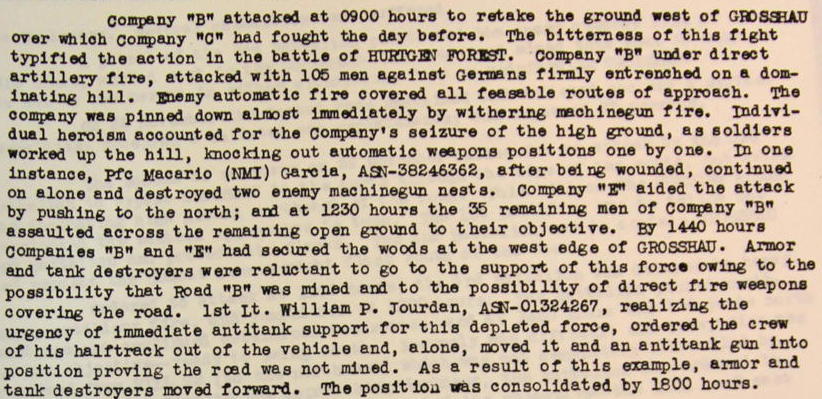
Above: A section of the
After Action Report of the 22nd Infantry for the month of
November 1944.
Macario Garcia is mentioned by name in the report.
Courtesy of John Tomawski
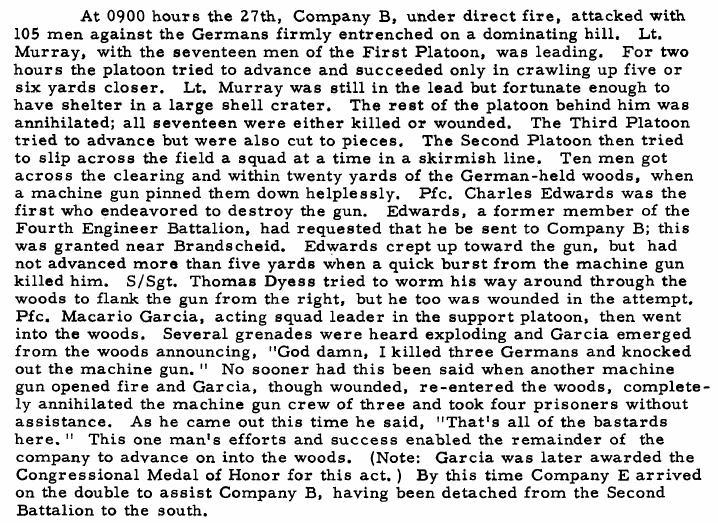
Above: The description
of the events of November 27, 1944 in the history of the 22nd
Infantry
in World War II as written by the Chaplain of the Regiment.
Garcia is mentioned by name in the report.
From HISTORY OF THE
TWENTY-SECOND UNITED STATES INFANTRY in World War II
by Dr. William S. Boice Pub. 22nd Infantry Regiment Society 1959
pp. 73
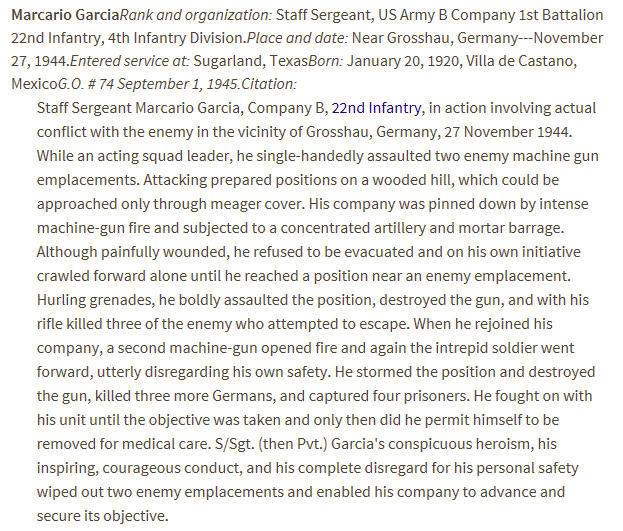
Above: The citation for the award of the Medal of Honor to Macario Garcia
After his return to the United
States Garcia was on duty at Fort Hood, Texas, training troops
for the upcoming planned
invasion of Japan. While at Fort Hood Garcia was notified in July
1945 that he was to report to Washington, D.C. for
participation in an award ceremony where he would receive the
Medal of Honor. 10
He was awarded the Medal of
Honor by President Harry S. Tuman in a ceremony at the White
House
on August 23, 1945.
Staff Sergeant Macario Garcia was discharged from the United States Army on October 8, 1945.
In January 1946 Macario Garcia
was one of five Hispanic recipients of the Medal of Honor
who were invited to Mexico to receive awards by the Mexican
Government. Garcia was first awarded
the Medalla al Mérito Militar (Medal of Military Merit) in a
ceremony on one day and in a second ceremony
the next day he was awarded the Orden Mexicana del Águila Azteca
(Mexican Order of the Aztec Eagle.)
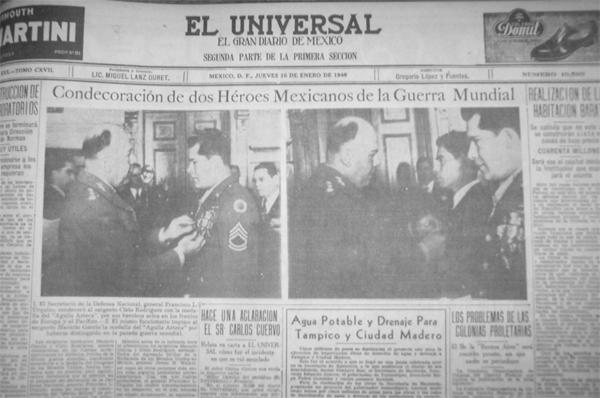
Above: Front page of the
Mexico City newspaper El Universal for January 10, 1946
showing the recipients of medals by the Mexican government.
Photo from Seize Occupy and Defend The
Priceless Legacy of Staff Sergeant Macario Garcia
by Robert Bailey and Katherine Bailey, Lulu Publishing 2014 pp.
157

Above: Mexican Secretary
of National Defense Lieutenant General Francisco Luis Urquizo
awards
Macario Garcia the Mexican Order of the Aztec Eagle from the
Mexican Government January 1946.
Garcia is second from the right in the photo.
Photo from Seize Occupy and Defend The
Priceless Legacy of Staff Sergeant Macario Garcia
by Robert Bailey and Katherine Bailey, Lulu Publishing 2014 pp.
157
In 1953 Garcia joined the United States Army Reserves.
In 1965 he was promoted to First
Sergeant. In 1967 he was promoted to Sergeant Major. He would
eventually attain the rank
of Command Sergeant Major. In 1968 "Mac" as he became
known, volunteered to go to Vietnam where he would be assigned
to the 22nd Replacement Battalion at Cam Ranh Bay where he would
spend six months counseling returning veterans on their
benefits upon returning to the states. 11
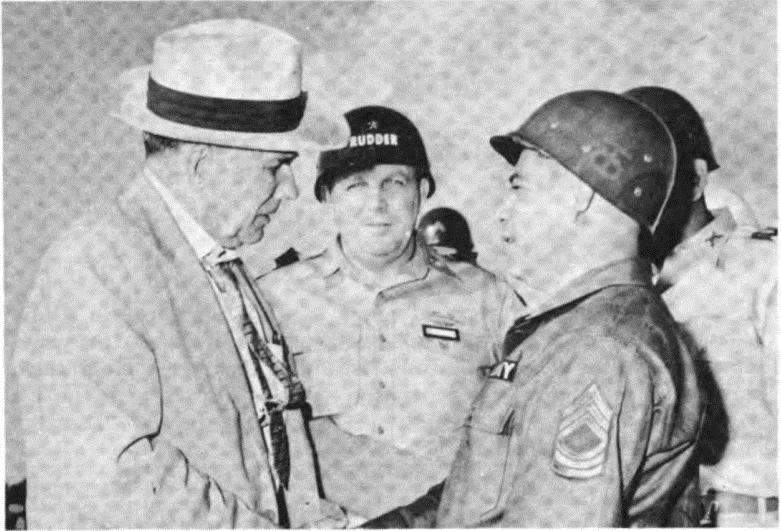
Master Sergeant
Macario Garcia on the right with the 90th Infantry Division in
1957.
In the center is Brigadier General James Earl Rudder, Commanding
General of the 90th Infantry Division.
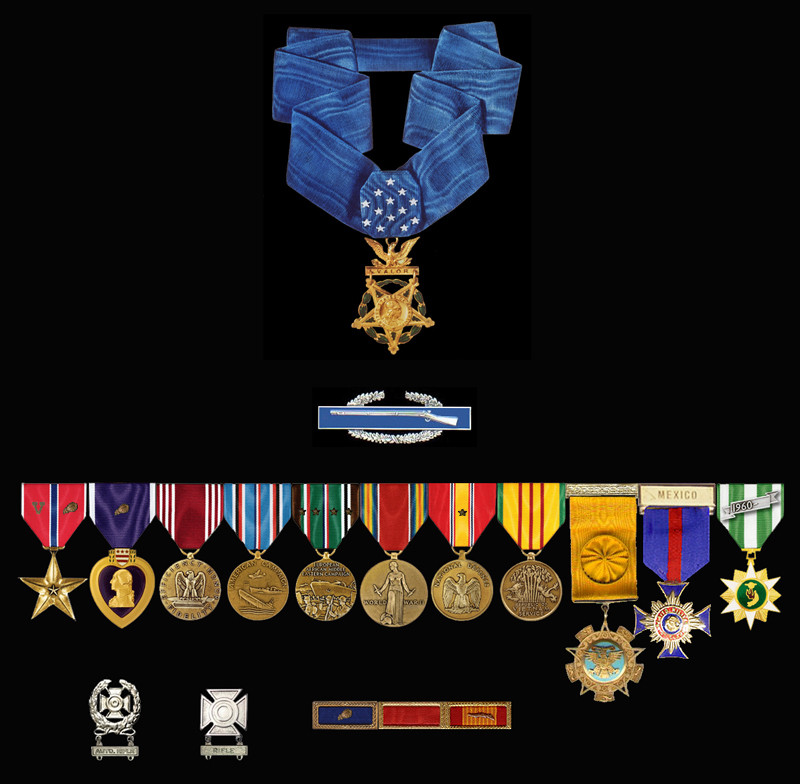
Macario Garcia's decorations
1st row: Medal of Honor
2nd row: Combat Infantryman Badge
3rd row left to right: Bronze Star
Medal with V device and oak leaf cluster, Purple Heart with oak
leaf cluster,
Good Conduct Medal, American Campaign Medal,
European-African-Middle Eastern Campaign Medal with
four bronze service stars, World War II Victory Medal, National
Defense Service Medal with bronze service star,
Vietnam Service Medal, Orden Mexicana del Águila Azteca, Medalla
al Mérito Militar, Republic of Vietnam Campaign Medal
4th row left to right: Expert Automatic
Rifle, Sharpshooter Rifle, Presidential Unit Citation with oak
leaf cluster,
Meritorious Unit Commendation, Republic of Vietnam Gallantry
Cross Unit Citation with palm
Note: The above decorations are based on the best available research as of June 2017.

Above: Macario Garcia was also awarded the Belgian Fourragere
1 From an article by Chris Fernandez posted on the Dream Act-Texas website
2 Seize Occupy and Defend The
Priceless Legacy of Staff Sergeant Macario Garcia
by Robert Bailey and Katherine Bailey, Lulu Publishing 2014 pp.
29
3 Ibid. pp. 34
4 NCO Journal November 14, 2013
5 Seize Occupy and Defend The
Priceless Legacy of Staff Sergeant Macario Garcia
by Robert Bailey and Katherine Bailey, Lulu Publishing 2014 pp
103-104
6 Ibid. pp. 112-113
7 Ibid. pp. 116
8 Ibid. pp. 137-143
9 Ibid. pp. 147
10 Ibid. pp. 148
11 From an article by Chris Fernandez posted on the Dream Act-Texas website
Home | Photos | Battles & History | Current |
Rosters & Reports | Medal of Honor | Killed in Action |
Personnel Locator | Commanders | Station List | Campaigns |
Honors | Insignia & Memorabilia | 4-42 Artillery | Taps |
What's New | Editorial | Links |